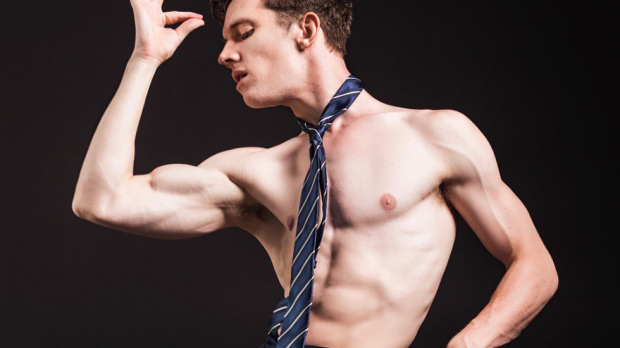
100 Years Of The History Of Dance As Told By One Man In 60 Minutes With An Energetic Group Finale @ Girls School
Thursday, February 13, 2020
100 Years of the History of Dance… is a one-man play conceived by Joseph Simons and Emma Canalese. Non-narrative in form, the play is more like a lecture-cum-performance. It is spirited, energetic, and vividly kinetic.
As 100 Years of the History of Dance… opens, the authoritative, pre-recorded voice of a teacher instructs the audience to turn off their phones and spit out their gum. The stage is pre-set with schoolboy Jacob (Joseph Simons), upstage right, seated atop a desk with his back to the audience. A flickering, black-and-white montage of dancers throughout history is projected overhead. As it concludes, Jacob swivels theatrically to face the crowd, ready to deliver his oral report on the history of dance.
Earnest and endearing, Jacob is a high school student with an infectious obsession with the art of dance. The rushed but halting pace of the performance and its hand-made mise-en-scène cultivates an impression of organic spontaneity. These qualities also lend the character and his world a likeable air of vulnerability. Poignantly, Jacob describes dance as a “single fleeting moment where you feel alive.” At the beginning, the performance is somewhat static and restrained but becomes increasingly liberated, impassioned, and raw. With boundless movement and energy, it moves from the dry, disciplined realm of academia to an uncontained and overflowing adoration for the art of dance. It culminates in an audience-interactive group finale, with Jacob encouraging the crowd to dance with him. The audience response was somewhat reluctant in the cramped auditorium seating, but Simons’ enthusiasm and vigour are nonetheless contagious.
The performance is peppered with moments of comic relief. Jacob’s excessive physicality – emergent in his flamboyant gestures, his sweeping gesticulations, and the way he saunters and swans across the stage – is engaging and exciting to watch. Much of the humour is campy and kitsch – for example, the observation that Shakira is the “queen of dance” according to “Buzzfeed.” Some of the humour is more scathing. In one especially clever use of sound, Simons lip-syncs to a pre-recorded discussion of Paula Abdul, explaining bitingly that he is doing so because “she did.”
At one point, Jacob abruptly begins to undress, the incongruity and absurdity of the action humourously juxtaposed with his thoughtful oration. Barely dressed, Jacob quips that Rudolf Nureyev “would have loved Grindr”, a thin sheen of sweat glistening on his well-sculpted body. The image could be taken as a proud celebration of the homoerotic gaze.
The meat of the performance is in its comprehensive theoretical discussions of dance, complete with Jacob’s physical demonstrations. A recurrent theme is the distinction between “referencing” and “copying”, with Jacob eventually coming to the conclusion that “everyone is influenced by everyone else.” The discussion of originality and influence across the history of the arts frequently arises in arts disciplines, and 100 Years of the History of Dance… enlivens this discussion for a fresh audience. Jacob offers the audience a stylistic kaleidoscope from myriad dancers and choreographers across history. He embodies the “personification of grief” in Martha Graham’s work – under cold blue lights and accompanied by discordant, striking piano keys, he contorts his body, tightly bound in a sheet, reminiscent of a state of rigor mortis. He describes Bob Fosse’s “quirky, sexy” oeuvre with pelvic thrusts and rhythmic clicks, bathed in a heated red glow and accompanied by upbeat jazz. He demonstrates the lyricism and elegance of Rudolf Nureyev with flourishing pirouettes and leaps.
Importantly, the performance emphasises the cultural importance of dance – as an art form, as an ancient ritual, and as an innate and universally human phenomenon. As Jacob meaningfully observes, “Dance is for everyone.”
AMBER GALBRAITH